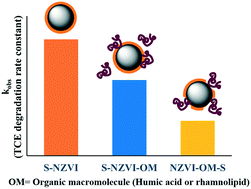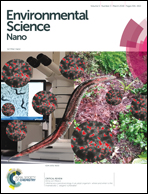Sulfidation of nanoscale zerovalent iron in the presence of two organic macromolecules and its effects on trichloroethene degradation†
Abstract
Sulfidation of nanoscale zerovalent iron (NZVI) enhances its reactivity to chlorinated organic contaminants such as trichloroethene (TCE). However, the effects of groundwater composition on the reactivity of sulfidated NZVI are not well understood. In this study we evaluated the effects of sulfidation on the reactivity of NZVI to TCE in the presence of two organic macromolecules, namely humic acid (HA) and rhamnolipid (RL). The NZVI was sulfidated under two different scenarios: (i) pre-sulfidation wherein NZVI was first sulfidated and subsequently contacted with RL or HA (ii) post-sulfidation wherein NZVI was first contacted with RL or HA and then sulfidated. Both scenarios resulted in decreases in NZVI reactivity, although the rates and extents were different. For pre-sulfidation, pseudo first order TCE degradation rates were reduced from 0.055 h−1 to 0.011 h−1 over a smaller range of RL concentrations (25 to 150 mg TOC per g NZVI) compared to HA (500 to 986 mg TOC per g NZVI). The diminished reactivity was primarily related to differences in sorption characteristics of the two organic macromolecules to the sulfide layer on sulfidated NZVI. In the post-sulfidation approach, more drastic decreases in reactivity were observed compared to the pre-sulfidated approach due to reduction in sulfide deposition on NZVI surface. The reduced deposition was caused by blocking of sulfide deposition sites by adsorbed RL and a combination of blocking of deposition sites and bisulfide complexation by HA. Sulfides and organic macromolecules are abundant in the subsurface, and this study shows that their presence can significantly alter NZVI and S-NZVI reactivity.

- This article is part of the themed collection: Best Papers 2018 – Environmental Science: Nano


 Please wait while we load your content...
Please wait while we load your content...